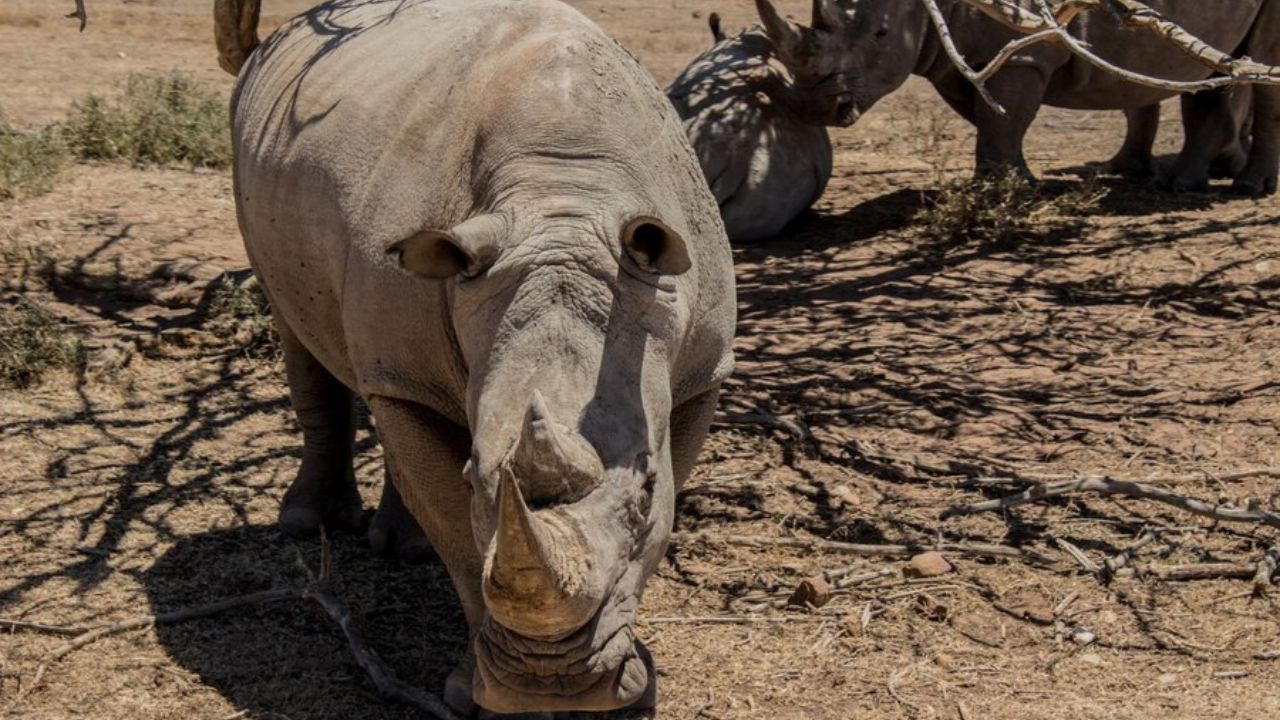HOME
Rhino skull: A Comprehensive Guide

In the heart of the African savanna and the lush forests of Asia roam some of the most majestic creatures on Earth – rhinos. But have you ever stopped to think about the incredible structure that supports their powerful horns and strong jaws? Yes, we’re talking about the rhino skull. This comprehensive guide will walk you through everything you need to know about the enigmatic rhino skull, its anatomy, functions, and much more.
The Anatomy of a Rhino Skull
The rhino skull is a marvel of nature. It’s not just a simple bone structure but a complex assembly designed to support the animal’s massive horn and robust musculature.
Cranial Structure
Rhino skulls are characterized by their large size and robust construction. The cranial bones are thick and dense, designed to withstand the significant forces exerted by the rhino’s muscular neck and powerful bites. The nasal bone, where the horn is anchored, is particularly dense, providing a solid base for the horn.
Horn Attachment
A rhino’s horn is made of keratin, the same material found in human hair and nails. Unlike other horned animals, a rhino’s horn doesn’t have a bony core but is instead anchored directly to the skull’s nasal bone. This unique attachment allows it to grow continuously throughout the rhino’s life.
Jaw and Dental Structure
Rhinos have a distinctive jaw structure that allows them to grind down tough vegetation. Their teeth are specially adapted for this purpose, with large molars and premolars that work like a millstone, breaking down fibrous plant material into digestible pieces.
Functions of the Rhino Skull
The rhino skull isn’t just a protective casing for the brain; it plays several critical roles in the animal’s survival and day-to-day activities.
Support for the Horn
The primary function of the rhino skull is to support the horn. The skull’s thick nasal bones provide a sturdy foundation, enabling the rhino to use its horn for digging, fighting, and foraging without damaging its head.
Muscle Attachment
The skull also serves as an anchor point for the powerful muscles needed for chewing and head movements. These muscles attach to various points on the skull, enabling the rhino to move its head with great force and precision.
Protection
Of course, like any skull, the rhino skull protects the brain and sensory organs. The thick bone acts as a shield against physical trauma, ensuring the rhino can continue to function even in the rough and tumble of their natural habitat.
Differences Between Species
There are five species of rhinos, and while their skulls share many similarities, there are also critical differences that reflect their unique lifestyles and habitats.
White Rhino
The white rhino has a broad, flat skull designed for grazing on grasses. The nasal bones are particularly large to support the rhino’s impressive horn.
Black Rhino
In contrast, the black rhino has a more pointed skull, adapted for browsing on leaves and branches. This species also has a prehensile upper lip, which it uses to grasp foliage, and the skull reflects this adaptation with a more pronounced nasal area.
Indian, Javan, and Sumatran Rhinos
The three Asian species of rhino have skulls that are more similar to each other than to their African counterparts. Their skulls are generally smaller and less robust, reflecting their different feeding habits and the denser vegetation of their habitats.
The Evolution of Rhino Skulls
The rhino skull has evolved over millions of years, adapting to changes in the environment and the animal’s diet.
Early Ancestors
Early rhino ancestors had much smaller horns and simpler skull structures. Over time, as the species evolved and adapted to different environments, their skulls grew larger and more complex.
Adaptations for Feeding
Changes in available food sources drove much of this evolution. Rhinos that fed on grasses developed broader, flatter skulls, while those that browsed on leaves evolved more pointed skulls.
Modern Rhinos
Today’s rhinos represent the pinnacle of this evolutionary process. Their skulls are perfectly adapted to their environments and lifestyles, allowing them to thrive in a variety of habitats.
Rhino Skulls in Culture and History
The rhino skull has held a place of fascination in human culture for centuries.
Ancient Myths and Legends
In many cultures, the rhino was seen as a symbol of strength and power. Its skull and horn were often used in rituals and were believed to hold magical properties.
Art and Symbolism
Artists throughout history have been inspired by the rhino’s unique appearance. From cave paintings to modern sculpture, the rhino skull has been a popular subject.
Modern Conservation Efforts
Today, the rhino skull is a symbol of the fight against poaching and habitat destruction. Conservationists use images of rhino skulls to raise awareness and funds for their efforts to protect these magnificent animals.
Collecting and Studying Rhino Skulls
For scientists and collectors alike, the rhino skull is an object of great interest.
Scientific Research
Scientists study rhino skulls to learn more about the species’ evolution, behavior, and health. By examining the structure and wear patterns of the teeth, researchers can gain insights into the rhino’s diet and lifestyle.
Ethical Considerations
Collecting rhino skulls is not without controversy. It is illegal to buy or sell them in many parts of the world due to concerns about conservation and animal rights. However, museums and legal collections play an important role in education and research.
Preserving Rhino Skulls
Proper preservation of rhino skulls is essential for both scientific study and cultural heritage. Techniques for cleaning and maintaining these specimens have advanced significantly, ensuring they can be studied and appreciated for generations to come.
Protecting Rhinos and Their Skulls
Conservation efforts are critical to ensuring that rhinos, and their incredible skulls, continue to exist.
Anti-Poaching Measures
Poaching remains one of the biggest threats to rhinos. Conservation groups employ a variety of strategies, from armed patrols to drones, to protect these animals.
Habitat Conservation
Preserving the habitats where rhinos live is equally important. Efforts to combat deforestation and create protected areas are vital to the survival of rhino populations.
Public Awareness
Raising public awareness about the plight of rhinos is crucial. Campaigns that highlight the beauty and importance of rhinos help garner the support needed to fund conservation efforts.
The Role of Zoos and Sanctuaries
Zoos and sanctuaries play an important role in rhino conservation.
Breeding Programs
Captive breeding programs help ensure the survival of species that are critically endangered in the wild. These programs also provide opportunities for research and education.
Education and Outreach
Zoos and sanctuaries educate the public about rhinos and the challenges they face. By fostering a connection between visitors and these animals, they help build support for conservation efforts.
Rehabilitation and Release
Some sanctuaries focus on rehabilitating injured or orphaned rhinos and preparing them for release back into the wild. These efforts are essential for maintaining healthy, sustainable populations.
How You Can Help
There are many ways you can contribute to rhino conservation.
Support Conservation Organizations
Donating to organizations that work to protect rhinos is one of the most effective ways to help. Many groups offer opportunities for direct involvement as well.
Raise Awareness
Sharing information about rhinos and their conservation status helps raise awareness and build support for efforts to protect them.
Make Responsible Choices
Choosing products that do not harm rhinos or their habitats is another way to make a positive impact. Avoiding products made from rhino horn and supporting sustainable practices helps protect these animals.
Conclusion
The rhino skull is a remarkable structure, reflecting millions of years of evolution and adaptation. By understanding and appreciating this unique feature, we can better appreciate the incredible animals it belongs to and the importance of conserving them. Whether through scientific study, cultural appreciation, or active conservation efforts, there are many ways we can all contribute to protecting rhinos and ensuring their survival for generations to come.
HOME
Waterproof RGB LED Strips: High-Performance Lighting Built for Rain, Heat, and Humidity

Introduction
Lighting is a critical element in creating functional, safe, and visually appealing spaces. Whether you’re illuminating outdoor patios, gardens, commercial walkways, or architectural features, you need lighting solutions that can withstand environmental challenges. This is where Waterproof RGB LED Strip shines. Designed for durability, versatility, and high performance, these LED strips are perfect for applications exposed to rain, heat, or humidity. Paired with a reliable Waterproof Power Supply, they offer long-lasting, vibrant illumination for both residential and commercial projects.
What Are Waterproof RGB LED Strips?
Waterproof RGB LED Strips are LED lighting solutions encased in a protective layer that shields the LEDs from moisture, dust, and external environmental factors. The “RGB” feature means they can produce red, green, and blue colors, allowing users to mix and create millions of colors for mood lighting, accent lighting, or dynamic visual effects.The waterproof design makes these LED strips ideal for outdoor installations. Whether you want to highlight your garden path, illuminate a swimming pool edge, or create colorful lighting for a commercial outdoor space, these LED strips provide reliable performance even under challenging weather conditions.
Benefits of Waterproof RGB LED Strips
Waterproof RGB LED Strips offer multiple advantages over traditional LED lighting. Their main benefit is resistance to water, dust, and heat, which ensures consistent performance regardless of environmental conditions. These strips are energy-efficient, consume minimal electricity, and generate less heat compared to conventional lighting, which makes them both cost-effective and safe.
When paired with a Waterproof Power Supply these LED strips operate smoothly, maintain consistent brightness, and avoid potential damage caused by voltage fluctuations or moisture. This combination ensures a long-lasting and reliable lighting solution for any environment.
Applications of Waterproof RGB LED Strips
The applications of Waterproof RGB LED Strips are vast and varied. In residential settings, they are perfect for outdoor patios, balconies, gardens, and pool areas. Their color-changing capability allows homeowners to create dynamic lighting moods for parties, relaxing evenings, or seasonal decorations.
In commercial spaces, these LED strips are widely used in hotels, restaurants, bars, retail stores, and event venues. They can highlight architectural features, illuminate pathways, or create eye-catching decorative effects. Because they are waterproof and resistant to humidity and heat, businesses can rely on them for long-term performance without frequent replacements or maintenance.
Choosing the Right Waterproof Power Supply
A Waterproof Power Supply is essential for ensuring the safety and efficiency of outdoor LED installations. It protects the system from electrical hazards caused by moisture, rain, or high humidity, and guarantees consistent voltage to the LED strips. Selecting a high-quality waterproof power supply ensures that your Waterproof RGB LED Strips operate at peak performance and maintain their vibrant colors and brightness over time.
When choosing a power supply, consider the total wattage of your LED strips, the IP rating for waterproofing, and the reliability of the manufacturer. Investing in a high-quality power supply prevents malfunctions, extends the life of the LEDs, and provides peace of mind for both residential and commercial installations.
Why Waterproof RGB LED Strips Are Worth the Investment
Investing in Waterproof RGB LED Strips is not just about lighting; it’s about durability, aesthetics, and safety. Their high-performance design ensures that your outdoor spaces remain beautifully illuminated in all weather conditions. Unlike standard LED strips, waterproof versions resist damage from water and humidity, making them ideal for long-term installations.
Paired with a reliable Waterproof Power Supply, these LED strips provide consistent, vibrant, and energy-efficient lighting. For contractors, designers, and homeowners alike, choosing high-quality waterproof LED strips ensures that outdoor spaces look impressive and function reliably year-round.
Conclusion
Waterproof RGB LED Strips are the ultimate solution for high-performance outdoor lighting. Designed to withstand rain, heat, and humidity, these LED strips provide versatile, energy-efficient, and long-lasting illumination for residential and commercial projects. By pairing them with a quality Waterproof Power Supply, you ensure safety, consistency, and vibrant colors for years to come.Whether you are lighting up a garden, a patio, a commercial façade, or a pool area, investing in waterproof LED solutions guarantees that your spaces remain visually stunning, functional, and reliable under any environmental condition.
HOME
Rehabilitation Services: Helping Seniors Regain Independence

The Importance of Independence for Seniors
Maintaining autonomy is a cornerstone of well-being for older adults. Being able to make daily decisions, pursue hobbies, and manage personal routines contributes to both mental and emotional health. Independence fosters confidence, reduces stress, and helps seniors feel in control of their own lives, which can positively impact overall quality of life. Even small acts, like preparing meals or going for a walk, provide a sense of purpose and accomplishment that is essential for maintaining dignity as one ages.
For seniors requiring additional support, selecting the proper care environment can preserve their sense of autonomy while ensuring safety. A skilled nursing home facility Missouri, for example, balances professional medical care with opportunities for residents to engage in meaningful activities and maintain daily routines. This approach enables seniors to receive necessary assistance without compromising their independence or personal autonomy.
Core Components of Rehabilitation: Physical, Occupational, and Speech Therapies
Physical Therapy
Physical therapy aims to restore mobility, improve balance, and enhance strength, particularly for seniors. Custom programs often follow surgeries such as hip or knee replacements, focusing on targeted exercises to expedite recovery and prevent future injuries. Therapists employ various techniques, including stretching, strength exercises, and balance training, to alleviate pain and address mobility challenges, thereby fostering a more active and secure lifestyle for seniors who engage in activities such as walking, gardening, or light sports.
Occupational Therapy
Occupational therapy helps seniors relearn practical skills and daily activities, such as dressing, bathing, and meal preparation, by utilizing adaptive techniques and devices to enhance their independence. Therapists assess and modify environments to enhance safety and accessibility, fostering independence and minimizing accident risks.
Speech Therapy
Speech therapy is essential for individuals with speech or swallowing challenges due to strokes, neurological disorders, or surgery. Therapists create tailored exercises to enhance communication and ensure safe swallowing, thereby improving quality of life and social engagement. Support often includes language exercises, memory training, and speech clarity strategies, with more serious cases benefiting from augmentative and alternative communication tools.
How Technology Is Transforming Rehabilitation
Innovative technologies, such as robotic exoskeletons, motion sensors, and wearable fitness trackers, are significantly enhancing rehabilitation for seniors. These tools offer safe guided movements, real-time feedback, and motivating virtual reality environments, thereby improving rehabilitation outcomes and enhancing senior engagement. Moreover, video-based therapy and telehealth services expand accessibility for seniors in remote areas, allowing them to receive care from home.
The Role of Recreational Activities in Recovery
Recreational activities play a crucial role in senior rehabilitation by complementing traditional therapy. Engaging in hobbies such as gardening, music, or crafts helps alleviate loneliness and depression while promoting gentle physical activity. Activities such as art classes and music therapy foster fine motor skills and cognitive engagement. Group activities enhance social interaction and provide a sense of connection and accomplishment, ultimately improving mental health, strengthening social bonds, and boosting overall wellness, thereby creating an environment conducive to recovery.
Adapting Homes for Independent Living
Simple home modifications for seniors, such as grab bars, ramps, and non-slip flooring, can significantly improve safety and accessibility during rehabilitation. Other enhancements, including wider doorways, better lighting, stair lifts, and accessible bathrooms, are also beneficial. Occupational therapists often suggest personalized adjustments to facilitate mobility and prevent falls, thereby reducing anxiety for both seniors and their families by ensuring a secure living environment.
Community-Based Rehabilitation and Support Programs
Community-based rehabilitation programs, such as PACE, support seniors by providing medical care, therapy, transportation, and social events, thereby promoting independence and reducing hospitalizations. These initiatives address physical, social, and psychological needs, while local resources enhance accessibility and encourage engagement through volunteer work and educational events, thus preventing isolation.
Conclusion
Rehabilitation services are crucial for seniors who wish to maintain their independence. Through the strategic combination of traditional therapies, technological innovations, recreational activities, home modifications, and supportive community programs, older adults are empowered to overcome challenges and lead fulfilling, self-reliant lives. As the field of rehabilitation continues to advance and adapt, more seniors will have the opportunity to enjoy active, independent years with the dignity they deserve.
HOME
The Cultural Significance of Digital Libraries in Modern Society

Quiet Revolutions in Reading
Books have always been more than just paper and ink. They hold stories that shape beliefs memories that span centuries and blueprints for futures not yet written. But the shelf space needed to store all this knowledge? That’s gone digital. Now readers tap rather than turn swipe instead of shelve. The shift toward e-libraries has quietly redrawn the cultural map of reading.
In this reshaped landscape https://z-lib.qa continues to play an essential role in global access to knowledge. More than a platform it functions as a virtual public square where readers from Lagos to Lisbon explore works once locked away in elite institutions. And that matters. Because the kind of access once defined by geography and privilege is now redefined by bandwidth and curiosity.
Where Books Meet Borders
Digital libraries don’t care where someone lives. That’s a radical change. For decades certain texts were simply out of reach—too expensive too obscure or too politically sensitive. Now those same titles appear on screens in seconds. This borderless reach isn’t just convenient. It’s cultural currency.
Imagine a young student in a rural town exploring Renaissance philosophy or Indigenous literature without needing a visa or travel grant. That student gains not just knowledge but a sense of inclusion in a larger conversation. And with global access comes global responsibility. The way people engage with ideas now carries weight far beyond their hometowns.
How E-Libraries Shape Cultural Memory
The past lives online. Every digitized manuscript journal or novel becomes a preserved artifact not just of content but of context. Digital libraries serve as living archives echoing voices that might otherwise be forgotten. When a rare text is scanned and shared it joins a chorus of perspectives that broaden how culture is remembered.
And this isn’t just about old books. New authors self-publish on e-library platforms finding readers without the backing of major publishers. Their stories enter the cultural bloodstream without gatekeepers filtering the flow. Some of these works eventually influence public debates inspire films or stir political discussions. One entry in a digital library can spark something far bigger than itself.
Different Ways Digital Libraries Are Changing the Game
This shift doesn’t just impact what people read but how they engage with the world. Consider three key areas where this change is most visible:
-
Knowledge Without Permission
Traditional libraries often come with sign-up sheets ID checks and limited hours. E-libraries remove these hurdles. Readers no longer wait for books to become available. They download what they need when they need it. That freedom can be a lifeline especially in places with few physical libraries.
-
Diverse Voices Gain Ground
Writers once pushed to the margins now find loyal readers. From queer poets in Manila to historians in Nairobi digital libraries level the playing field. They don’t just reflect culture—they reshape it by elevating new voices and disrupting old hierarchies.
-
Learning Becomes Personal
With countless books at their fingertips readers mix and match topics in ways traditional curricula rarely allow. Someone exploring post-colonial theory might stumble into art history then pivot to climate science. That nonlinear path mirrors how culture really grows—messy layered and full of surprise.
In some corners of the web like reddit communities even share ways to connect with these libraries despite censorship or access barriers. This grassroots energy reflects how deeply people value the ability to read what they choose.
As digital libraries continue growing their influence seeps into everything from how textbooks are updated to how protest slogans are written. Literature no longer waits quietly in stacks. It lives among people on screens and in stories they pass on. The shift is already here. Now it’s just a question of how much further it can go.
-

 HEALTH2 years ago
HEALTH2 years agoIntegrating Semaglutide into Your Weight Loss Plan: A Practical Guide
-

 HOME IMPROVEMENT2 years ago
HOME IMPROVEMENT2 years agoHow to Choose the Perfect Neutral Area Rug for Every Room
-

 LAW1 year ago
LAW1 year agoTeenage Drivers and Car Accidents in California: Risks and Parental Liability
-

 CONSTRUCTION1 year ago
CONSTRUCTION1 year agoConstruction Site Safety Regulations in New York and Your Rights as a Worker
-

 LAW1 year ago
LAW1 year agoPost-Divorce Considerations in California: Modifications and Long-Term Planning
-

 HOME2 years ago
HOME2 years agoSandra Orlow: The Teen Model Who Captivated the Internet
-

 FINANCE1 year ago
FINANCE1 year agoDigital Asset Management in Florida Estate Planning
-

 LAW1 year ago
LAW1 year agoKentucky’s School Football: Concussions, Injuries, and Legal Options
